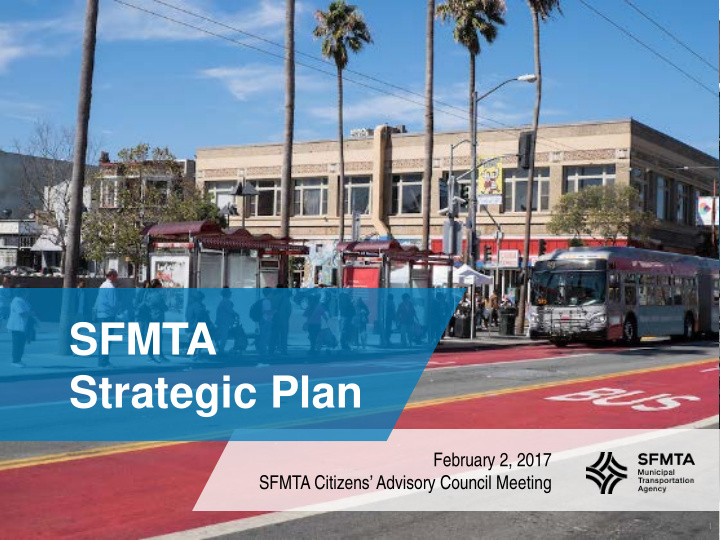



SFMTA Strategic Plan February 2, 2017 SFMTA Citizens’ Advisory Council Meeting 1
FY 2013 – FY 2018 Strategic Plan SFMTA Vision San Francisco: great city, excellent transportation choices. SFMTA Mission Statement We work together to plan, build, operate, regulate and maintain the transportation network, with our partners, to connect communities. 2
FY 2013 – FY 2018 Strategic Plan Goals GOAL 1: SAFETY GOAL 2: TRAVEL CHOICES GOAL 4: SERVICE GOAL 3: LIVABILITY 3
Key Performance Indicators (FY2013–FY2016) Improvements in: Keeping steady: • Muni Security • Workplace Injuries • Customer Ratings • Mode share • Reducing gaps • Transit Cost per Revenue Hour • On-time performance • Employee Rating • % of SF park Spaces with No Rate Change • Performance Plan & Appraisal Completion • SFMTA CO2 Emissions • Economic Impact of Muni Delays ($M) Still need to improve: • Capital projects delivered • Muni Collision Reduction on-budget by phase • Transit Vehicle bunching 4
San Francisco Growth San Francisco has experienced a 17.6% growth in jobs since 2010, along with a 7.6% population increase. 5 Source: MTC Vital Signs, 2016
San Francisco Commute Times Commute time has increased for both private auto and transit use 6 Source: MTC Vital Signs, 2016
San Francisco Transportation Mode Split Mode share has remained steady over the past several years. Travel Mode Share in San Francisco, Fiscal Year (FY) 2013 – FY 2016 7 Source: SFMTA 2016 Annual Report
Alternative modes of travel to Muni Alternatives if Muni not available, 2015 vs. 2016 Ridesharing services have Direction of Travel Mode 2015 2016 % Change change taken an Ride a bicycle 3% 4% increasing 1% share of non- Use other transit 9% 12% 3% such as BART Muni transit Modes Increasing Use ridesharing modes between 18% 29% 11% services 2015 and 2016, Walk 20% 21% 1% with “driving alone” taking a Drive 21% 14% -7% smaller share of Get a ride 9% 6% -3% Modes all modes. Decreasing Use taxi 12% 9% -3% Would not have 8% 5% -3% made a trip 8 Source: SFMTA Ridership Survey (Corey, Canapary & Galanis Research, 2016)
Muni On-Time Performance Muni on-time performance is relatively stable, with a 3% increase in FY 2016. Muni On-Time Performance, Fiscal Year (FY) 2013 – FY 2016 9 Source: SFMTA 2016 Annual Report
City & County of San Francisco Overall ratings of Muni service have improved, with the share of “Excellent and “good” ratings increasing from 52% in 2014 to 70% in 2016. 10 Source: SFMTA Ridership Survey (Corey, Canapary & Galanis Research, 2016)
SFMTA Carbon Footprint An overall reduction in fuel use and a shift to renewable sources has reduced the agency’s footprint. CO2e Emissions by Type, Fiscal Year (FY) 2009 – FY 2016 11 Source: https://www.sfmta.com/about-sfmta/reports/performance-metrics
2016 Legislation – City & Regional measures In the Bay Area, transit and infrastructure funding measures were passed: • Measure KK in Oakland to fund street improvements • Measure B in Santa Clara County approved a half-cent sales tax to fund key transportation projects in the South Bay. • Measure C1 will fund more frequent, reliable bus service for AC Transit in the East Bay. • Measure RR will fund much needed BART upgrades and system improvements. In San Francisco, voters supported transit improvements ( Proposition J ) but rejected the sales tax that would have provided the funding ( Proposition K ). San Francisco voters also affordable housing legislation to issue over $260 million in affordable housing bonds ( Proposition C ) and increase the household income threshold for residents to qualify for affordable housing ( Proposition U ). 12
Discussion of the Agency’s Strategic Direction 13
Recommend
More recommend